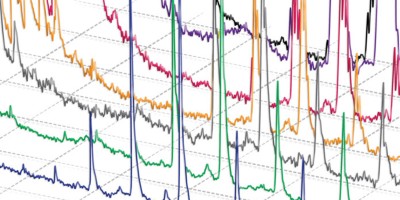Abstract
The zinc ion has a key role in a variety of physiological and pathological processes. As a consequence, the development of sensitive and reliable methods to monitor the presence of zinc ions in cells and organisms is of great importance to biological research and biomedical applications. This protocol describes detailed procedures for the five-stage synthesis of a zinc ion–selective, cyanine-based fluorescent probe, CTMPA, from 2,6-bis(hydroxymethyl)pyridine. In addition, we describe its applications in the detection of Zn2+ released during apoptosis in cells and endogenous Zn2+ in living zebrafish. Notably, the use of CTMPA enabled our research group to monitor for the first time the presence of zinc ions in neuromasts of zebrafish via fluorescence. The approximate time frame for the synthesis of CTMPA is 4–5 d, and for its use in bioimaging is 8–10 h for cells and 2 h for zebrafish.




Similar content being viewed by others
References
Frederickson, C.J., Koh, J.Y. & Bush, A.I. The neurobiology of zinc in health and disease. Nat. Rev. Neurosci. 6, 449–462 (2005).
Tomat, E. & Lippard, S.J. Imaging mobile zinc in biology. Curr. Opin. Chem. Biol. 14, 225–230 (2010).
Koh, J.Y. et al. The role of zinc in selective neuronal death after transient global cerebral ischemia. Science 272, 1013–1016 (1996).
Fraker, P.J. & King, L.E. Reprogramming of the immune system during zinc deficiency. Annu. Rev. Nut. 24, 277–298 (2004).
Van Trump, W.J. & McHenry, M.J. The morphology and mechanical sensitivity of lateral line receptors in zebrafish lavae (Danio rerio). J. Exp. Biol. 211, 2105–2115 (2008).
Truong-Tran, A.Q., Carter, J., Ruffin, R.C. & Zalewski, P.D. The role of zinc in caspase activation and apoptotic cell death. BioMetals 14, 315–330 (2001).
Stefano, L.S., Pierre, P., Ashley, I.B. & Israel, S. Zinc in the physiology and pathology of the CNS. Nat. Rev. Neurosci. 10, 780–791 (2009).
Valeur, B. Molecular Fluorescence: Principles and Applications (Wiley-VCH, 2002).
Xu, Z., Yoon, J. & Spring, D.R. Fluorescent chemosensors for Zn2+. Chem. Soc. Rev. 39, 1996–2006 (2010).
Domaille, D.W., Que, E.L. & Chang, C.J. Synthetic fluorescent sensors for studying the cell biology of metals. Nat. Chem. Biol. 4, 168–175 (2008).
Nolan, E.M. & Lippard, S.J. Small-molecule fluorescent sensors for investigating zinc metalloneurochemistry. Acc. Chem. Res. 42, 193–203 (2009).
Yang, Y.K., Ko, S.K., Shin, I. & Tae, J. Synthesis of a highly metal-selective rhodamine-based probe and its use for the in vivo monitoring of mercury. Nat. Protoc. 2, 1740–1745 (2007).
Dickinson, B.C., Lin, V.S. & Chang, C.J. Preparation and use of MitoPY1 for imaging hydrogen peroxide in mitochondria of live cells. Nat. Protoc. 8, 1249–1259 (2013).
Guo, Z., Kim, G., Shin, I. & Yoon, J. A cyanine-based fluorescent sensor for detecting endogenous zinc ions in live cells and organisms. Biomaterials 33, 7818–7827 (2012).
Guo, Z., Nam, S., Park, S. & Yoon, J. A highly selective ratiometric near-infrared fluorescent cyanine sensor for cysteine with remarkable shift and its application bioimaging. Chem. Sci. 3, 2760–2765 (2012).
Zheng, H. et al. A heptamethine cyanine-based colorimetric and ratiometric fluorescent chemosensor for the selective detection of Ag+ in an aqueous medium. Chem. Commun. 48, 2243–2245 (2012).
Peng, X. et al. Heptamethine cyanine dyes with a large stokes shift and strong fluorescence: a paradigm for excited-state intramolecular charge transfer. J. Am. Chem. Soc. 127, 4170–4171 (2005).
Qian, F. et al. Visible light excitable Zn2+ fluorescent sensor derived from an intramolecular charge transfer fluorophore and its in vitro and in vivo application. J. Am. Chem. Soc. 131, 1460–1468 (2009).
Xu, Z. et al. Zn2+-triggered amide tautomerization produces a highly Zn2+-selective, cell-permeable, and ratiometric fluorescent sensor. J. Am. Chem. Soc. 132, 601–610 (2010).
Kwon, J.E. et al. Fluorescent zinc sensor with minimized proton-induced interferences: photophysical mechanism for fluorescence turn-on response and detection of endogenous free zinc ions. Inorg. Chem. 51, 8760–8774 (2012).
Ko, S.K., Chen, X., Yoon, J. & Shin, I. Zebra fish as a good vertebrate model for molecular imaging using fluorescent probes. Chem. Soc. Rev. 40, 2120–2130 (2011).
Palmiter, R.D. The elusive function of metallothioneins. Proc. Natl. Acad. Sci. USA 95, 8428–8430 (1998).
Li, C. et al. Ratiometric and colorimetric fluorescent chemosensor for Ag+ based on tricarbocyanine. Dyes Pigments 99, 903–907 (2013).
Hu, C. et al. A ratiometric near-infrared fluorescent probe for hydrazine and its in vivo applications. Org. Lett. 15, 4023–4025 (2013).
Wang, X. et al. A near-infrared ratiometric fluorescent probe for rapidand highly sensitive imaging of endogenous hydrogen sulfide in living cells. Chem. Sci. 4, 2551–2556 (2013).
Acknowledgements
This work was supported by the National Creative Research Initiative program (grant no. 2010-0018272 to I.S. and 2012R1A3A2048814 to J.Y.). Z.G. acknowledges National 973 Program (2013CB733700), National Natural Science Foundation of China (61177034) and Shanghai Pujiang Program (13PJD010).
Author information
Authors and Affiliations
Contributions
Z.G. and G.-H.K. conducted experiments; Z.G., G.-H.K., J.Y. and I.S. designed experiments and wrote the paper.
Corresponding authors
Ethics declarations
Competing interests
The authors declare no competing financial interests.
Rights and permissions
About this article
Cite this article
Guo, Z., Kim, GH., Yoon, J. et al. Synthesis of a highly Zn2+-selective cyanine-based probe and its use for tracing endogenous zinc ions in cells and organisms. Nat Protoc 9, 1245–1254 (2014). https://doi.org/10.1038/nprot.2014.086
Published:
Issue Date:
DOI: https://doi.org/10.1038/nprot.2014.086
- Springer Nature Limited
This article is cited by
-
A multicolor and ratiometric fluorescent sensing platform for metal ions based on arene–metal-ion contact
Communications Chemistry (2021)
-
Determination of Zinc Ion by a Quinoline-Based Fluorescence Chemosensor
Journal of Fluorescence (2020)
-
A Colorimetric and Fluorescent Chemosensor for the Selective Detection of Cu2+ and Zn2+ Ions
Journal of Fluorescence (2017)
-
Synthesis of a highly HOCl-selective fluorescent probe and its use for imaging HOCl in cells and organisms
Nature Protocols (2016)





